-
Call Now
1800-102-2727
Snail: Skeletal System, Practice Problems and FAQs
You might have blown the balloons during some celebrations like birthday parties. What is the shape of a balloon before and after blowing? It is different, right? How does it change? The air inside the balloon is giving it a particular structure. Just like it, we also have something inside our body which gives us a particular shape. What is it? Yes, it is the skeletal system!!
The structural framework of an organism is maintained by the skeletal system. The movement of the body and the protection of internal organs are the two major functions of the skeletal system. Most of the animals have a skeletal system inside their body and it is called endoskeleton. Do you think this skeletal system always exists inside every organism? The answer is no. There are some animals like crabs, centipedes, and snails which have a skeletal system outside their body. It is called exoskeleton. There are some other animals like turtles, which have both endoskeleton and exoskeleton.

Fig: Animals with exoskeleton
Any hard surface which covers the outer surface of an organism is called a shell. Shells are very common in prey animals and they use the shells for the protection from predators rather than the protection of internal organs. Shell of a snail is one such exoskeleton which is very familiar to most of us. So we are going to discuss more about the skeletal system of a snail in this article.
Table of contents
- Snail
- Skeletal system of snail
- Functions of exoskeleton
- Practice Problems
- FAQs
Snail
Snail is an invertebrate animal which is included in the phylum Mollusca and the order Gastropoda. The presence of hard calcareous shells is a characteristic feature of most of the members in the phylum Mollusca. The body of a snail is also composed of an external calcareous shell which is secreted by the mantle (a soft layer of skin).
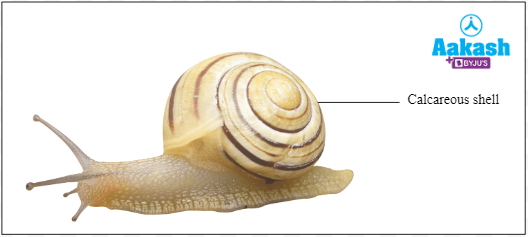
Fig: Calcareous shell in snail
Body parts of snail
Snail has an unsegmented body with three major parts. They are as follows:
Head
It is located in the anterior part with tentacles and radula (rasping organ).
Muscular foot
It is located in the ventral part which aids in locomotion and anchorage.
Visceral hump
It is located on the upper part of the body and is covered by the mantle. It holds the bulk of the reproductive, digestive, respiratory and excretory systems.
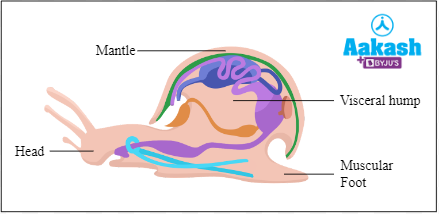
Fig: Body parts of a snail
Mantle cavity of snail
Mantle is a soft and spongy layer of skin which covers the visceral hump. It is also known as pallium. Mantle cavity is the cavity or space between the visceral hump and the mantle. This cavity is also called the pallial cavity. This cavity is composed of feathery gills or ctenidia which helps in the respiration.
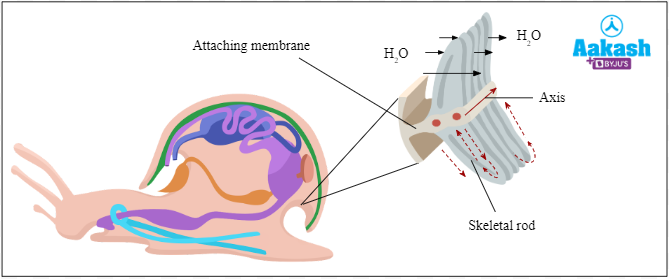
Fig: Gaseous exchange in snails
Skeletal system of snail
Structural framework of an organism is supported by their skeletal system. The skeletal system of a snail is composed of its calcareous shell. It lacks bony structures but it is hard. This skeletal system is called exoskeleton, since it is present outside the body of the animal.

Fig: Exoskeleton of snail
Most of the land snails have a coiled shell which is attached over the mantle by a strong muscle. The body of the snail can be completely withdrawn inside this shell. This is done for their protection from the predators or they do it while resting. The shell is generally yellow or brown in colour with fringe designs.

Fig: Snail escaping from predation
Growth of exoskeleton
The ectoderm or epithelial cells of the mantle tissue secretes the material needed for the formation of the shell. The outer part of the shell is formed first and then the internal thickened layers are formed. The calcareous shell can grow along with the snail and stays all along their life. The shell of a juvenile snail that just hatches from the egg will have only a single whorl of 360 degree rotation from the centre. As the snail grows, the number of whorls also increases. Different numbers of whorls are observed in different species of snails.
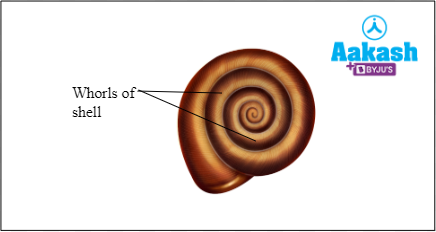
Fig: Whorls of a snail’s shell
Structure of exoskeleton
The exoskeleton or the shell of a snail is a non cellular structure made up of chitin reinforced with calcium carbonate and a protein covering. The exoskeleton is composed of very little protein (2%).
The mantle or body is directly attached with the exoskeleton. The shell is strengthened due to the proteins and calcium released from the mantle. Calcium acts as the cleaning agent and protein is the building block of the shell. The internal organs of the snail are present under this shell.
Morphology of the snail exoskeleton
The major morphological parts of a snail exoskeleton are as follows:
Apex
It is the pointed tip of the shell.
Suture
It is the visible line on the shell due to indentation of whorls.
Spire
It includes all the whorls except the body whorls.
Body whorl
It is the first revolution of the shell where most of the visceral mass resides.
Aperture
It is the opening of the shell where the head-foot part emerges.
Columella
It is the central anatomical feature that runs from apex to the midpoint of the undersurface of the shell.
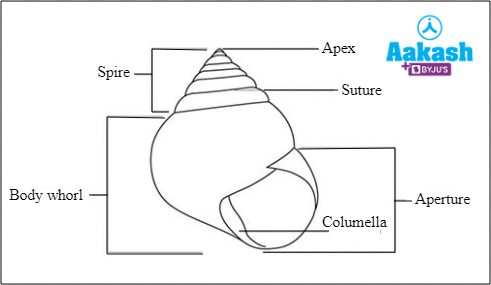
Fig: Morphology of snail exoskeleton
Anatomy of the snail exoskeleton
The shell has three layers and they are as follows:
- Periostracum
- Prismatic layer
- Nacre pearly layer
Periostracum
The outermost thin layer of the shell is called periostracum. It is an organic coating made up of proteins called conchiolins. This layer is resistant to abrasion and it also provides colour to the shell.
Prismatic layer
Prismatic layer is the middle layer of the shell. It is made up of calcium carbonate and hence called the calcareous layer. Calcium carbonate is precipitated into an organic matrix made up of complex proteins called conchiolin.
Nacre pearly layer or nacreous layer
The inner layer of the shell which connects the body of the snail is called nacre pearly layer. It is composed of nacre which is also a compound present in the pearl. This layer is a smooth layer. Nacre is composed of calcium carbonate (CaCO3) aragonite platelets and biological macromolecules like matrix proteins and chitin.
Structure of chitin
Chitin is a structural homopolysaccharide which is a polymer of N-acetyl glucosamine. It consists of repeating units of a nitrogen-containing glucose derivative called N-acetyl glucosamine (NAG). It is considered as the second most abundant organic substance.
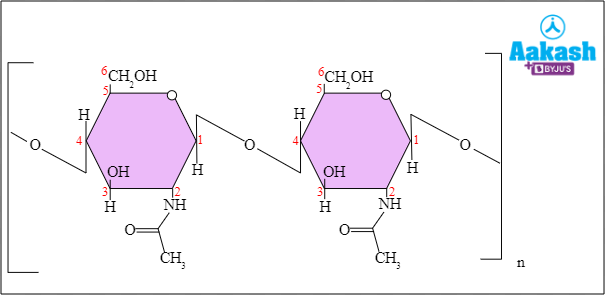
Fig: Structure of chitin
Chirality of the shell
If an object or molecule can not be superimposed on its mirror image by any translations or rotations, then the object or molecule is called chiral and the phenomenon is called chirality. This phenomenon is applicable to the coiling of shells in snails.
Coiling of shells
The shells of the snails are spirally coiled. It is helically coiled around a central axis, and the opening or aperture is present on one side or the other side of the axis of coiling. Coiling is of two types such as dextral and sinistral.
Dextral coiling
Most of the snails have dextral shells which means, the coiling pattern of the shell will be right handed. This can be observed in 90 percent of the gastropods.

Fig: Dextral coiling of shells
Sinistral coiling
The rest of the 10 percent snails show sinistral shells, which means they show left handed coiling.

Fig: Sinistral coiling of shells
Dimorphic coiling
Some species of land snails show a mixture of individuals with dextral and sinistral coiling. It is called dimorphic coiling. Examples include Amphidromus perversus.
Inheritance of coiling
The coiling of shells is the best example for maternal inheritance in snails. In maternal inheritance the coiling phenotype is controlled by the genotype of the mother.
Functions of exoskeleton
The major functions of the exoskeleton of a snail are as follows:
- Protection of organisms from external stress.
- Protection of organisms from predator attack.
- Supporting the framework of the body.
- Contraction of the muscles are enabled.
- Promotes body movements.
Practice Problems
1. What is a mantle cavity?
a. Soft and spongy layer of skin
b. Cavity between the visceral hump
c. Space between muscular foot and visceral hump
d. Cavity between calcareous shell and head
Solution: Mantle is a soft and spongy layer of skin which covers the visceral hump. It is also known as pallium. Mantle cavity is the cavity or space between the visceral hump and the mantle. This cavity is also called the pallial cavity. This cavity is composed of feathery gills or ctenidia which helps in the respiration. Hence the correct option is b.
2. Which of the following statements are wrong about the skeletal system of snails?
a. The skeletal system is composed of calcareous shell
b. It has an exoskeleton
c. Coiled shell is the exoskeleton attached over the visceral hump
d. Exoskeleton protects from predation
Solution: Structural framework of an organism is supported by their skeletal system. The skeletal system of a snail is composed of its calcareous shell. But it lacks bony structures and it is hard. This skeletal system is called exoskeleton, since it is present outside the body of the animal. Most of the land snails have a coiled shell which is attached over the mantle by a strong muscle. The body of the snail can be completely withdrawn inside this shell. This is done for their protection from the predators or they do it while resting. It is generally yellow or brown in colour with fringe designs. Hence the correct option is c.
3. Match the following column A with column B.
|
Column A (Layers of shell) |
Column B (Chemical composition) |
|
I) Periostracum |
i) Nacre |
|
II) Prismatic layer |
ii) Proteins |
|
III) Nacre pearly layer |
iii) Calcium carbonate |
a. I - i, II - ii, III - iii
b. I - ii, II - iii, III - i
c. I - i, II - iii, III - ii
d. I - iii, II - ii, III - i
Solution: The exoskeleton or the shell of a snail is a non cellular structure made up of chitin reinforced with calcium carbonate and a protein covering. The exoskeleton is composed of very little protein (2%). The shell has three layers and they are periostracum, prismatic layer and nacre pearly layer. The outermost thin layer of the shell is called periostracum. It is an organic coating made up of proteins called conchiolin. This layer is resistant to abrasion and it also provides colour to the shell. The middle layer of the shell is called the prismatic layer. It is made up of calcium carbonate and hence called the calcareous layer. Calcium carbonate is precipitated into an organic matrix made up of complex proteins called conchiolin. The inner layer of the shell which connects the body of the snail is called nacre pearly layer or nacreous layer. It is composed of nacre which is also a compound present in the pearl. This layer is a smooth layer. Hence the correct option is b.
4. Which of the following is the coiling pattern of the exoskeleton of snails?
a. Dextral
b. Sinistral
c. Mixture of dextral and sinistral
d. All the above
Solution: If an object or molecule can not be superimposed on its mirror image by any translations or rotations, then the object or molecule is called chiral and the phenomenon is called chirality. This phenomenon is applicable to the coiling of shells in snails.The shells of the snails are spirally coiled. It is helically coiled around a central axis, and the opening or aperture is present on one side or the other side of the axis of coiling. Coiling is of two types such as dextral and sinistral.
- Dextral coiling - Most of the snails have dextral shells which means, the coiling pattern of the shell will be right handed. This can be observed in 90 percent of the gastropods.
- Sinistral coiling - The rest of the 10 percent snails show sinistral shells, which means left handed coiling.
- Dimorphic coiling - Some species of land snails show a mixture of individuals with dextral and sinistral coiling. It is called dimorphic coiling. Examples include Amphidromus perversus. Hence the correct option is d.

Fig: Coiling of shells in snails
FAQs
1. What is Aplacophora?
Answer: The class of small deep water molluscs without the shell are called Aplacophora. Only some primitive forms of Aplacophora have valves. They are exclusively benthic and marine.
2. How does the shell of Stenotrema florida differ from other snails?
Answer: Stenotrema florida is a land snail which has a shell that gives a velvety look and feel, because of the minute hairs on it. The periostracum layer of the shell in this species is developed into minute hairs.

Fig: Stenotrema florida
3. What is the reason behind the snail losing its shell?
Answer: Snail loses its shell when it is about to die. At this time, the body of the snail shrinks and the mantle decomposes. As a result the shell detaches from the mantle. If a snail loses its shell, it will dry up their body and eventually die.
4. What is a slug?
Answer: The shell-less terrestrial gastropod molluscs are called slug (Limax). Sometimes they will have reduced shells or very small inter shells. The slugs evolved according to convergent evolution.

Fig: Limax
YOUTUBE LINK: https://www.youtube.com/watch?v=2V-RxvwschU&t=280s



